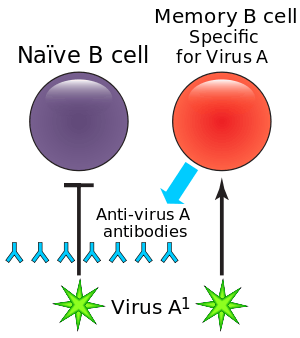Memory B cell

Memory B cells are a B cell sub-type that are formed within germinal centers following primary infection and are important in generating an accelerated and more robust antibody-mediated immune response in the case of re-infection (also known as a secondary immune response).[1][2]
Primary response
During an initial infection (or primary immune response) involving a T-dependent antigen, naive follicular B cells are activated in the presence of TFH cells within the follicles of secondary lymphoid organs (i.e. spleen and lymph nodes) and undergo clonal expansion to produce a foci of B cells that are specific for the antigen. Most of these clones differentiate into the plasma cells, also called effector B cells which produce a first wave of protective antibodies and help clear the infection, but a fraction persist as dormant memory cells that survive in the body on a long-term basis after having gone through a highly mutative and selective germinal center reaction.[3] Activated B cells that fail to undergo germinal center differentiation do not persist as effective memory B cells and are rapidly negatively selected against.
Within germinal centers, B cells proliferate and mutate the genetic region coding for their surface antibody (also known as immunoglobulin). The process is called somatic hypermutation and is responsible for introducing spontaneous mutations with a frequency of about 1 in every 1600 cell division (a relatively high frequency considering the low mutation frequency of other cells of the body being 1 in 106 cell divisions). Then after gaining a set number of mutations, germinal center B cells are subjected to a round of selection by TFH cells. B cell clones that have mutated and gained higher affinity surface immunoglobulin that better recognize antigen receive cellular contact-dependent survival signals from interacting with their cognate TFH cells[4] and go on to one of three fates: (i) differentiate into plasma cells that have improved affinity towards antigen (therefore more efficient than their earlier the generation of plasma cells in clearing the infection), (ii) affinity matured memory B cells, or (iii) retained in the germinal center to re-enter another round of mutative replication and TFH cell-dependent selection. Therefore, as an infection proceeds, memory B cells selected in the later stages of a germinal center response are found to have accumulated the highest numbers of immunoglobulin mutation events with superior affinity towards their targeted antigen. Conversely, during the course of a germinal center reaction, low affinity or potentially auto-reactive germinal center B cell clones, or those that have gained non-functional mutations are out-competed by higher affinity clones and eventually undergo cellular apoptosis.
Secondary response and memory
With each such subsequent exposure to the same antigen, the number of different responding B cell clones increases to generate a polyclonal response and effectively a greater number of memory B cells persist. Thus, a stronger antibody response (i.e. higher titres of more diverse antibody molecules) having improved affinity towards antigen is typically observed in the secondary immune response. It is unclear at what stage such a model reaches saturation to provide an optimal level of antibody-mediated immune protection against the same antigen. However, the fact that all the accumulation of cells of a single clone population express many of the one same type of antibody and that these memory B cells survive for long periods of time in a body underscores their functional significance during vaccination and the administration of booster shots.
See also
References
- ↑ Airoldi I, Raffaghello L, Cocco C, et al. (January 2004). "Heterogeneous expression of interleukin-18 and its receptor in B-cell lymphoproliferative disorders deriving from naive, germinal center, and memory B lymphocytes". Clin. Cancer Res. 10 (1 Pt 1): 144–54. doi:10.1158/1078-0432.CCR-1026-3. PMID 14734463.
- ↑ Lang ML (Aug 2009). "How do natural killer T cells help B cells?". Expert Rev Vaccines. 8 (8): 1109–21. doi:10.1586/erv.09.56. PMC 2747240
 . PMID 19627191.
. PMID 19627191. - ↑ Gatto D.; Brink R. (Nov 2010). "The germinal center reaction.". Journal of Allergy and Clinical Immunology. 126: 898–907; quiz 908–9. doi:10.1016/j.jaci.2010.09.007. PMID 21050940.
- ↑ Victora GD, Nussenzweig MC (2012). "Germinal Centers.". Annual Review of Immunology. 30: 429–57. doi:10.1146/annurev-immunol-020711-075032. PMID 22224772.